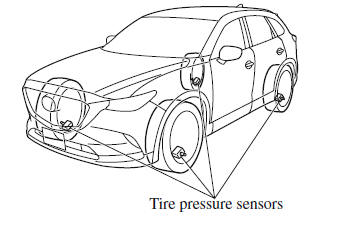Mazda CX-9 Owners Manual: Tire Pressure Monitoring System
Tire Pressure Monitoring System The Tire Pressure Monitoring System (TPMS) monitors the pressure for each tire. If tire pressure is too low in one or more tires, the system will inform the driver via the warning light in the instrument cluster and by the warning beep sound. The tire pressure sensors installed on each wheel send tire pressure data by radio signal to the receiver unit in the vehicle.
NOTE When the ambient temperature is low due to seasonal changes, tire temperatures are also lower. When the tire temperature decreases, the air pressure decreases as well. The TPMS warning light may illuminate more frequently. Visually inspect the tires daily before driving, and check tire pressures monthly with a tire pressure gauge. When checking tire pressures, use of a digital tire pressure gauge is recommended. TPMS does not alleviate your need to check the pressure and condition of all four tires regularly. CAUTION
System Error Activation When the warning light flashes, there may be a system malfunction. Consult an Authorized Mazda Dealer. A system error activation may occur in the following cases:
Tires and Wheels CAUTION When inspecting or adjusting the tire air pressures, do not apply excessive force to the stem part of the wheel unit. The stem part could be damaged. Changing tires and wheels The following procedure allows the TPMS to recognize a tire pressure sensor's unique ID signal code whenever tires or wheels are changed, such as changing to and from winter tires. NOTE Each tire pressure sensor has a unique ID signal code. The signal code must be registered with the TPMS before it can work. The easiest way to do it is to have an Authorized Mazda Dealer change your tire and complete ID signal code registration. When having tires changed at an Authorized Mazda Dealer When an Authorized Mazda Dealer changes your vehicle's tires, they will complete the tire pressure sensor ID signal code registration. When changing tires yourself If you or someone else changes tires, you or someone else can also undertake the steps for the TPMS to complete the ID signal code registration. 1. After tires have been changed, switch the ignition ON, then back to ACC or OFF. 2. Wait for about 15 minutes. 3. After about 15 minutes, drive the vehicle at a speed of at least 25 km/h (16 mph) for 10 minutes and the tire pressure sensor ID signal code will be registered automatically. NOTE If the vehicle is driven within about 15 minutes of changing tires, the tire pressure monitoring system warning light will flash because the sensor ID signal code would not have been registered. If this happens, park the vehicle for about 15 minutes, after which the sensor ID signal code will register upon driving the vehicle for 10 minutes. Replacing tires and wheels CAUTION
Be sure to have the tire pressure sensors installed whenever tires or wheels are replaced. When having a tire or wheel or both replaced, the following types of tire pressure sensor installations are possible.
NOTE
|
See More:
Mazda CX-9 Owners Manual > Mazda Radar Cruise Control with
Stop & Go function (MRCC with
Stop & Go function): Cruise Control Function
While this function is operating, the headway control operation is canceled and only the cruise control function operates. The vehicle speed can be set more than about 25 km/h (16 mph). Use the cruise control function on expressways and other highways which do not require a lot of repeated accelerat ...



